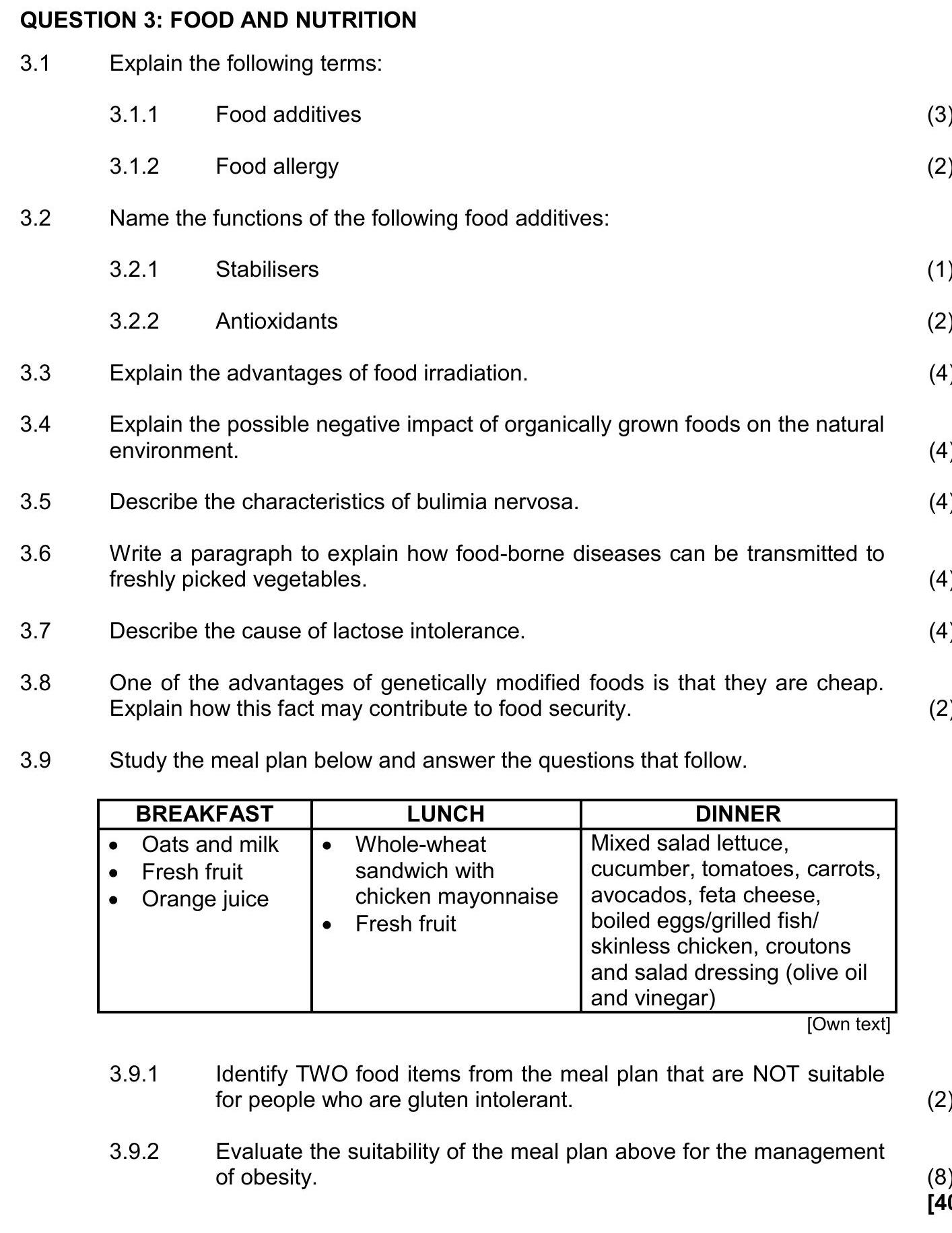Photo AI
3.1 Explain the following terms: 3.1.1 Food additives: Natural or chemical substances intentionally added to a food product during processing or production to perform a specific function - NSC Consumer Studies - Question 3 - 2023 - Paper 1
Question 3

3.1 Explain the following terms: 3.1.1 Food additives: Natural or chemical substances intentionally added to a food product during processing or production to perfo... show full transcript
Worked Solution & Example Answer:3.1 Explain the following terms: 3.1.1 Food additives: Natural or chemical substances intentionally added to a food product during processing or production to perform a specific function - NSC Consumer Studies - Question 3 - 2023 - Paper 1
Step 1
3.1.1 Food additives
Answer
Food additives are natural or artificial substances that are intentionally included in food products during their processing or production. Their purpose is to perform specific functions such as preserving the food, enhancing its flavor, improving its texture, or adding color to make the product more appealing.
Step 2
3.1.2 Food allergy
Answer
A food allergy occurs when a person's immune system mistakenly identifies a protein in food as harmful. In response, the immune system produces antibodies and may trigger symptoms such as rashes, stomach upset, or even severe reactions, known as anaphylaxis, which can be life-threatening.
Step 3
Step 4
Step 5
3.3 Explain the advantages of food irradiation.
Answer
Food irradiation is a process that uses ionizing radiation to destroy spoilage-causing microorganisms and pathogens, improving the safety and longevity of food products. This method can reduce the risk of foodborne illnesses, extend shelf-life, and help ensure a greater availability of food, particularly in regions facing scarcity.
Step 6
3.4 Explain the possible negative impact of organically grown foods on the natural environment.
Answer
While organic foods are marketed as environmentally friendly, their transportation can contribute to pollution and global warming, particularly if flown in from distant locations. Additionally, the need for more land to cultivate organic crops can lead to deforestation, and the use of certain permitted pesticides, such as copper sulfate, can be harmful to local ecosystems, including earthworms and fish.
Step 7
3.5 Describe the characteristics of bulimia nervosa.
Answer
Bulimia nervosa is characterized by repeated episodes of binge eating, followed by compensatory behaviors such as purging, fasting, or excessive exercise. Individuals with this disorder often exhibit severe dissatisfaction with their body shape and weight, leading to secretive eating patterns and potential health complications such as dental issues, esophageal damage, and electrolyte imbalances.
Step 8
3.6 Write a paragraph to explain how food-borne diseases can be transmitted to freshly picked vegetables.
Answer
Food-borne diseases can be transmitted to freshly picked vegetables through various means. If the soil has been contaminated, for instance, by animal waste, the vegetables can carry pathogens. Furthermore, if individuals handling the vegetables do not wash their hands properly after using the toilet or handling contaminated equipment, they can introduce harmful bacteria to the produce. Lastly, if the vegetables themselves are not cleaned thoroughly, they can retain pathogens, putting consumers at risk.
Step 9
3.7 Describe the cause of lactose intolerance.
Answer
Lactose intolerance occurs when the body fails to produce sufficient amounts of lactase, the enzyme responsible for breaking down lactose, a sugar found in milk. This results in gastrointestinal discomfort, bloating, and other symptoms when lactose-containing foods are consumed, as undigested lactose ferments in the colon.
Step 10
3.8 Explain how genetically modified foods contribute to food security.
Answer
Genetically modified foods (GM foods) often have lower production costs, allowing them to be sold at lower prices. This affordability makes them more accessible to individuals in lower-income brackets, thereby helping to ensure that more people have access to nutritious food, which is a critical aspect of food security.
Step 11
Step 12
3.9.2 Evaluate the suitability of the meal plan above for the management of obesity.
Answer
The meal plan appears suitable for managing obesity as it includes three balanced meals that provide a range of nutrients. The breakfast includes oats and milk, which offer complex carbohydrates and protein. The lunch consists of a whole-wheat sandwich that is lower in refined grains and higher in fiber, contributing to satiety. Dinner includes a diverse array of vegetables and proteins, promoting a balanced diet that can help maintain a healthy weight.
